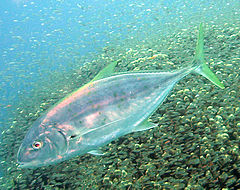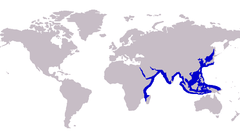- Orangespotted trevally
-
Orangespotted trevally 
Scientific classification Kingdom: Animalia Phylum: Chordata Class: Actinopterygii Order: Perciformes Suborder: Percoidei Superfamily: Percoidea Family: Carangidae Genus: Carangoides Species: C. bajad Binomial name Carangoides bajad
(Forsskål, 1775)
Approximate range of the orangespotted trevally Synonyms - Scomber ferdau bajad
Forsskål, 1775 - Caranx bajad
(Forsskål, 1775) - Caranx immaculatus
Ehrenberg, 1833 - Caranx auroguttatus
Cuvier, 1833 - Carangoides auroguttatus
(Cuvier, 1833) - Caranx fulvoguttatus var. flava
Klunzinger, 1871
The orangespotted trevally, Carangoides bajad (also known as the gold-spotted trevally) is a species of inshore marine fish in the jack family, Carangidae. The species is fairly common in tropical to subtropical waters of the Indo-Pacific, ranging from Madagascar in the west to Japan in the east, typically inhabiting inshore reefs. The species has characteristic orange-yellow spots on its sides, although counts of fin rays and scutes are needed to distinguish it from related species with similar colouring. Orangespotted trevally are powerful predators, taking a variety of small fish, nekton and crustaceans, and reach sexual maturity at around 25 cm. It is a moderately large fish, reaching a maximum known length of 55 cm. The species is occasionally taken by fishermen throughout its range, and is generally considered to be bycatch. The exception to this is in the southern Persian Gulf, where it makes up a large proportion of the fishery.
Contents
Taxonomy and naming
The orangespotted trevally is classified within the genus Carangoides, a group of fish commonly called jacks and trevallies. Carangoides falls into the jack and horse mackerel family Carangidae, itself part the order Perciformes, in the suborder Percoidei.[1]
The species was first scientifically described by the Swedish naturalist Peter Forsskål in 1775 based on a specimen taken from the Red Sea which he designated to be the holotype.[2] The specific epithet is an Arabic name of the fish (although it is now usually applied to a catfish, Bagrus bajad, which Forsskål also named), with the letter "j" transcribing a /j/ sound; Forsskål used this technique to name a number of Red Sea fish species.[3] Forsskål at first gave the new taxon subspecies status as Scomber ferdau bajad, relating it to the mackerels, and especially Scomber ferdau, which would later also be transferred to Carangoides. The taxon was later given a species rank, becoming Scomber bajad, then Caranx bajad, before being transferred to its current position as Carangoides bajad.[4]
The species was also independently renamed three times after Forsskål's description, the first coming from Christian Gottfried Ehrenberg, who named the species Caranx immaculatus, although he did not accurately publish the name, leading Georges Cuvier to rename the fish as Caranx auroguttatus in 1833, which was later transferred to Carangoides. In 1871, Carl Benjamin Klunzinger once again proposed a new subspecies (or variety) name for the fish, Caranx fulvoguttatus var. flava.[4] All names except Carangoides bajad are considered to be junior synonyms under the ICZN rules, and are rendered invalid and not used.
Description
The orangespotted trevally has the typical body profile of the genus Carangoides, having a moderately deep, compressed oblong shape, with the dorsal profile more convex than the ventral profile. It is a moderately large fish, growing up to 53 cm in length, although more common below 40 cm.[5] The dorsal profile of the head is quite straight from the snout to the nape, with an eye diameter smaller than the snout length. Both jaws contain narrow bands of villiform teeth, with these bands becoming wider anteriorly. The dorsal fin is in two parts, the first containing 8 spines and the second of 1 spine followed by 24 to 26 soft rays.[6] The anal fin is similar to the second dorsal fin although slightly shorter, and consists of two anteriorly detached spines followed by 1 spine and 21 to 24 soft rays. Another of the major diagnostic features for the species is the length of the anal fin lobe in comparison to the head length, with C. bajad having a head length longer than the anal fin lobe.[6] The lateral line has a slight, broad anterior curve, with this curved section being longer than the posterior straight section. The straight section of the lateral line has 14 to 26 scales followed by 20 to 30 scutes.[7] The chest of the orangespotted trevally is completely scaled, occasionally having a narrow naked region on the underside near the ventral fins. There are 24 vertebrae and a total of 25 to 43 gill rakers.[6]
The orangespotted trevally has a silvery grey to brassy coloured body, becoming paler to a silvery white ventrally. There are many conspicuous orange to yellow spots on the sides of the fish, giving the species its name, and make for an easy way to identify the fish in the field.[6] There have been records of a variant which is entirely yellow,[8] although it is thought the fish can rapidly change between its normal colour configuration and this entirely orange-yellow colour.[6] The colour of the fins range from hyaline to lemon yellow, and there is no dark opercular spot.[2]
Distribution and habitat
 A completely orange-yellow orangespotted trevally in Egypt
A completely orange-yellow orangespotted trevally in Egypt
The orangespotted trevally inhabits the tropical to subtropical waters of the Indian and west Pacific Oceans. It is distributed from Madagascar and the Comoros Islands in the west,[9] northwards to the Red Sea, the Gulf of Aden and the Persian Gulf and probably east toward India, although there have been few records in this region.[4] It is commonly found from the Gulf of Thailand to Okinawa, Japan in the east, and southward to Indonesia, Philippines and New Britain.[6] In 2005, it was reported that orangespotted trevally had been caught in the Mediterranean Sea, indicating they had become Lessepsian migrants, passing through the Suez Canal to extend their range.[10] This claim has been disputed though, with the source of the report coming under question due to the presence of other species unknown to the Mediterranean shown in the purported photograph.[11]
The orangespotted trevally is a coastal species, most common in inshore waters over rocky and coral reefs, where it is found both solitary and in schools at depths of 2 to 50 m. They are often observed patrolling the edges of seaward reefs, and have been known to mingle with Parupeneus cyclostomus.[12]
Biology and fisheries
The orangespotted trevally is a strong-swimming predator that takes a variety of prey including fish, crustaceans and nekton.[13] Orangespotted trevally reach sexual maturity at 24.7 cm on average, with studies in the Persian Gulf indicating the species main spawning periods occur between June and September. Whether this differs throughout the species range is currently unknown. The same study also showed the species has a strong seasonal oscillation in the growth rate, which was fastest during November–April and slowest during the summer May–September.[9]
The orangespotted trevally is occasionally taken throughout its range by hook and line, gill nets, and other artisanal gear, although in most areas is bycatch and does not form a large part of these fisheries.[6] There is one fishery that is highly dependent on the species that exists in the southern Persian Gulf. Here the orangespotted trevally is one of the most common fish found just above the sea floor, and is taken by wire traps and sold fresh at local markets. The combined catch of C. bajad and Gnathanodon speciosus totals around 1100 tonnes per year.[14] The development of the fishing fleet of the United Arab Emirates has caused a number of species to be overexploited, but the orangespotted trevally is still being taken at sustainable levels.[14]
References
- ^ "Carangoides bajad". Integrated Taxonomic Information System. http://www.itis.gov/servlet/SingleRpt/SingleRpt?search_topic=TSN&search_value=641977. Retrieved 29 March 2008.
- ^ a b Ludwig, Albert Carl; Gotthilf Günther (1860). Catalogue of the Fishes in the British Museum. pp. 238.
- ^ Baheyeldin, Khalid (October 17, 2004). "Forsskål's use of Arabic names for fish species". The Baheyeldin dinasty. http://baheyeldin.com/linguistics/forsskaal-arabic-species-names-fish-taxonomy.html.
- ^ a b c Froese, Rainer, and Daniel Pauly, eds. (2008). "Carangoides bajad" in FishBase. January 2008 version.
- ^ Randall, John E. (1995). Coastal Fishes of Oman. Honolulu: University of Hawaiʻi Press. pp. 183. ISBN 0-8248-1808-3.
- ^ a b c d e f g Carpenter, Kent E.; Volker H. Niem (eds.) (2001) (PDF). FAO species identification guide for fishery purposes. The living marine resources of the Western Central Pacific. Volume 4: Bony fishes part 2 (Mugilidae to Carangidae). Rome: Food and Agriculture Organization of the United Nations. pp. 2694. ISBN 92-5-104587-9. ftp://ftp.fao.org/docrep/fao/009/x2400e/x2400e52.pdf.
- ^ Lin, Pai-Lei; Shao, Kwang-Tsao (May 15, 1999). "A Review of the Carangid Fishes (Family Carangidae) From Taiwan with Descriptions of Four New Records". Zoological Studies 38 (1): 33–68. http://cat.inist.fr/?aModele=afficheN&cpsidt=10055944.
- ^ Myers, R.F.; Lieske, E. (2004). Coral Reef Guide Red Sea. London: Collins. ISBN 978-0007159864.
- ^ a b Grandcourt, E.M.; T.Z. Al Abdessalaam, F. Francis & A. Al Shamsi (2004). "Population biology and assessment of representatives of the family Carangidae Carangoides bajad and Gnathanodon speciosus (Forsskal, 1775), in the Southern Arabian Gulf". Fisheries Research 69 (3): 331–341. doi:10.1016/j.fishres.2004.06.008.
- ^ Öztürk, Bayrum (ed) (2005). Marine Life of Turkey in the Aegean and Mediterranean Seas. Istanbul: Turkish Marine Research Foundation (TÜDAV). ISBN 9758825070.
- ^ Golani, Daniel (2006). "The Indian scad (Decapterus russelli), (Osteichthyes: Carangidae), a new Indo-Pacific fish invader of the eastern Mediterranean". Scientia Marina 70 (4): 603–605. ISSN 0214-8358. http://www.icm.csic.es/scimar/index.php/secId/6/IdArt/3288/.
- ^ Siliotti, A. (2002). Fishes of the Red Sea. Verona. pp. 287. ISBN 88-87177-42-2.
- ^ Blaber, S.J.M.; Milton, D.A., Rawlinson, N.J.F., Tiroba, G. & Nichols, P.V. (1990). "Diets of lagoon fishes of the Solomon Islands: predators of tuna baitfish and trophic effects of baitfishing on the subsistence fishery". Fisheries Research 8 (3): 263–286. doi:10.1016/0165-7836(90)90027-S.
- ^ a b Grandcourt, E.; T.Z. Al Abdessalaam, F. Francis, A.T. Al Shamsi, K. Al Ali & S. Al Ali (2004) (PDF). Biological reference points, resource status and management options for the key demersal species of Abu Dhabi Emirate. Environmental Research and Wildlife Development. pp. 1–28. http://www.ead.ae/TacSoft/FileManager/cations/reports/2004%20Stock%20Assessment%20Report.PDF.
External links
Categories:- Carangoides
- Fish of the Red Sea
- Fish of Africa
- Fish of the Indian Ocean
- Scomber ferdau bajad
Wikimedia Foundation. 2010.
